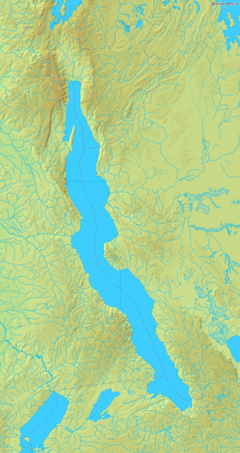Lake Tanganika
| Lake Tanganyika | |
|---|---|

Lake Tanganyika from space, June 1985
|
|

Lake Tanganyika map
|
|
| Coordinates | 6°30′S 29°50′E / 6.500°S 29.833°ECoordinates: 6°30′S 29°50′E / 6.500°S 29.833°E |
| Lake type | Rift Valley Lake |
| Primary inflows |
Ruzizi River Malagarasi River Kalambo River |
| Primary outflows | Lukuga River |
| Catchment area | 231,000 km2 (89,000 sq mi) |
| Basin countries |
Burundi DR Congo Tanzania Zambia |
| Max. length | 673 km (418 mi) |
| Max. width | 72 km (45 mi) |
| Surface area | 32,900 km2 (12,700 sq mi) |
| Average depth | 570 m (1,870 ft) |
| Max. depth | 1,470 m (4,820 ft) |
| Water volume | 18,900 km3 (4,500 cu mi) |
| Residence time | 5500 years |
| Shore length1 | 1,828 km (1,136 mi) |
| Surface elevation | 773 m (2,536 ft) |
| Settlements |
Kigoma, Tanzania Kalemie, DRC Bujumbura, Burundi |
| References | |
| 1 Shore length is not a well-defined measure. | |
Lake Tanganyika is an African Great Lake. It is the second oldest freshwater lake in the world, second largest by volume, and the second deepest, in all cases after Lake Baikal in Siberia; it is also the world's longest freshwater lake. The lake is divided among four countries – Tanzania, Democratic Republic of the Congo (DRC), Burundi, and Zambia, with Tanzania (46%) and DRC (40%) possessing the majority of the lake. The water flows into the Congo River system and ultimately into the Atlantic Ocean.
The name apparently refers to "Tanganika, 'the great lake spreading out like a plain', or 'plain-like lake'."
Lake Tanganyika is situated within the Albertine Rift, the western branch of the East African Rift, and is confined by the mountainous walls of the valley. It is the largest rift lake in Africa and the second largest lake by volume in the world. It is the deepest lake in Africa and holds the greatest volume of fresh water, accounting for 16% of the world's available fresh water. It extends for 676 km (420 mi) in a general north-south direction and averages 50 km (31 mi) in width. The lake covers 32,900 km2 (12,700 sq mi), with a shoreline of 1,828 km (1,136 mi), a mean depth of 570 m (1,870 ft) and a maximum depth of 1,470 m (4,820 ft) (in the northern basin). It holds an estimated 18,900 cubic kilometres (4,500 cu mi).
The catchment area of the lake is 231,000 km2 (89,000 sq mi). Two main rivers flow into the lake, as well as numerous smaller rivers and streams (whose lengths are limited by the steep mountains around the lake). There is one major outflow, the Lukuga River, which empties into the Congo River drainage.
...
Wikipedia
